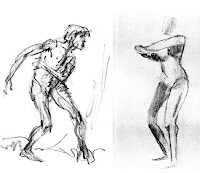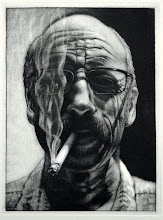
As the evening class gets closer to beginning their creative study the figure, we are beginning to explore the importance and necessity of gesture drawing. Gesture drawing is about the rhythmic movements and energies coursing through a subject rather than simply the subjects parts. It's about seeing and empathizing with the whole dynamic, concentrating on the essential pattern and general form of all the parts rather than the edges, or contours. I know it's hard to break away from those contours, but doing so will open up whole new arena of expression. A gesture drawing tells us what the figure is doing rather that what it looks like. Gesture drawing tells us about the actions, the tensions, and the pulsations that come from a figure's masses and their alignment in space. Gesture drawings are about the spirit rather than the specific. Practice in your journals gesturing folks you observe in the food court waiting in line, in the lobby by the gallery, studying in the lounge upstairs. 30 seconds here, 30 seconds there. Don't worry about what it looks like, but instead feel what it feels like. Practice.

I, for one, am new to gesture drawing. This was my first introduction putting it into practice. I have to say this is one tool that was missing from my toolbox. Even after that single session, I started to see what I was missing. I could visualize the symmetry of curves mirrored from one part of the figure into the next. I think this will make my figures look more natural instead of pieced together. Even the gestures of mannequins had more balance and seemed more natural. Thanks for the lesson! I'm sold.
ReplyDeleteI love gestures. Everytime I begin a piece I usually lay it out with a gesture first and it helps alot. I feel that it allows me to be more loose and expressive as well, and thats relieving in a way. I can also put down proportion more accurately and quickly using them. I do alot of figurative work and gesture drawings are essential to my creative process.
ReplyDeleteMy problem is that I'm just not a scribbler. Maybe it was those grade school teachers who always rapped on my knuckles if I colored outside of the lines.
ReplyDeleteI found another problem. I normally draw and sketch fairly dark. I have really had to lighten up in order to get a clean drawing over the gestures. I really like the gesture lines combined with more finished work overlay. No erasers for me!
ReplyDeleteI find gestures to be very difficult. I am a very tight drawer and to get loose is very hard for me. I usually follow the contours of the lines but I don't always have time to fill in the space. I need to work from the inside out, instead of from the outside in. I think this would help to create that gesture that you are looking for.
ReplyDeleteIt sounds like you get the gist of it, Tatum, just keep pushing to get a more fluid line, and yes, from the inside out.
ReplyDeleteI don't enjoy gesture drawing at all. I find it very difficult to draw a loose line and with speed. I like to draw one section at a time.
ReplyDeleteThis was my first time drawing a moving person other than the little bit we did in the 100 level last semester.
ReplyDeleteI found the 30 second drawings quite difficult. I tend to draw a bit slower and it's very hard for me to speed up like that. Shawn gave me advice on staying more stick figurish and I'll try that next time.
I was getting a bit better with our 30 minute drawings today and the flaws I did have I could clearly see. I know with practice I can master this.
I like the suggestions you made about where and when to practice out of class and keeping them short.
I agree with you Professor Jones. I think that in order to really get the feel of a model's stance or position, one must use gesture. I think gesture helps to introduce the round edges without using a solid black contour edge. When a model stands still, the drawer sketches him/her, but the stance of that person sometimes can portray motion. Many renaissance drawings/statues depict people in motion. Leonardo da Vinci quotes, "build a figure in such a way that its pose tells what is in the soul of it. A gesture is a movement not of a body but of a soul."
ReplyDeletethat gesture drawing that was posted is amazing. I have found that studying gesture has helped me in other areas of drawing on top of working with the figure. everything has a gesture, whether is be a tree or a tea kettle. working with gesture gives a good skeleton to begin building masses on top of.
ReplyDelete